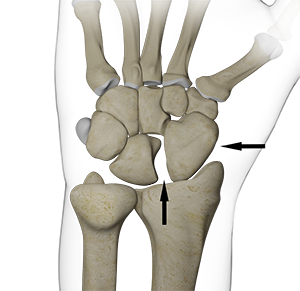
What is Scapholunate Dissociation?
Scapholunate dissociation is the abnormal orientation or movement of the small bones of your wrist, the scaphoid and lunate, in relation to one another.
Anatomy
The scaphoid and lunate are 2 of the 8 carpal bones in your wrist and are stabilized by a scapholunate interosseous ligament. They help to maintain wrist stability and movement.
Symptoms
The symptoms include:
- Pain in the wrist
- Swelling
- Stiffness
- Clicking sensation
- Weakness of the wrist
Causes
Trauma to the hand and wrist or a fall on an outstretched hand can cause injury to the scapholunate interosseous ligament, resulting in dissociation of the scaphoid and lunate bones.
Diagnosis
Your doctor will assess your symptoms, take your medical history, and perform a physical exam. Imaging tests such as X-ray, MRI or CT-scan may be ordered.
Diagnosis is confirmed through evidence of the following:
- Instability of the ligaments supporting the scaphoid and lunate bones
- Widening of the joint space between the bones
Treatment
Non-surgical Treatment
Your doctor will prescribe medicines as needed. Use of ice packs may be suggested to reduce inflammation in the acute phase. Other non-surgical treatment options include:
- Physical therapy
- Immobilization with a splint or cast
Surgical Treatment
Surgery may be recommended by your doctor if non-surgical treatment options are ineffective. This may be performed under general or local anesthesia. Wrist arthroscopy may be performed first to confirm the diagnosis and assess for additional injury or disease in the wrist. Scapholunate ligament repair involves the following steps:
- Your surgeon will make an small incision on the back of your wrist.
- The scapholunate interosseous ligament and the bones are exposed.
- Care is taken to prevent damage to the nerves.
- Debridement, or cleaning out the damaged tissue, is performed by your surgeon.
- K-wires may be used to stabilize the bones in their normal position
- The ligament may be repaired with the assistance of suture anchors.
- The repair may be augmented with heavy suture tape.
- Ocasionally, a tendon graft may be used to support the repaired ligament
- The incision is closed and a bandage is applied.
Your wrist is supported by a splint or for a few weeks. Your physiotherapist will teach you specific physical exercises to help you recover sooner. You should regularly follow up with your surgeon. You may return to normal activities after a few months with your surgeons approval.
Related Topics
- Wrist Fracture
- Fractures of the Hand and Fingers
- Wrist Sprain
- Flexor Tendon Injuries
- Distal Radioulnar Joint (DRUJ) Arthritis
- Ulnar Nerve Compression in Guyon's Canal
- Scaphoid Facture
- Industrial Hand Trauma
- Distal Radius Osteotomy to Correct Mal-Union (Crooked Painful Wrist)
- Distal Intersection Syndrome
- Distal Biceps Avulsion
- Adult Forearm Fractures
- Arthritis of the Hand and Wrist
- Arthritis of the Thumb
- Ganglion Cyst
- Boutonniere Deformity
- Carpal Tunnel Syndrome
- De Quervain's Tendinosis
- Dupuytren's Contracture
- Hand Pain
- Hand Infections
- Trapeziometacarpal (TMC) Arthritis
- Wrist Injuries
- Wrist Tumors
- Boxer's Fracture
- Swan Neck Deformity
- Carpal Instability
- Bennett's Fracture
- Kienbock's Disease
- Scapholunate Dissociation
- Triscaphoid Joint Arthritis
- Ulnar Carpal Impaction
- Triangular Fibrocartilage Complex Injury (TFCC)
- Guyon's Canal Syndrome
- Hand Masses
- Distal Radioulnar Joint (DRUJ) Instability
- Work Related Hand Injuries
- Wrist Ligament Tear and Instability
- Metacarpophalangeal Joint Arthritis





